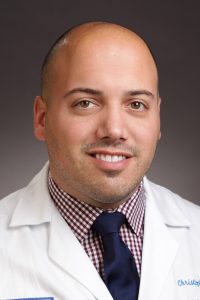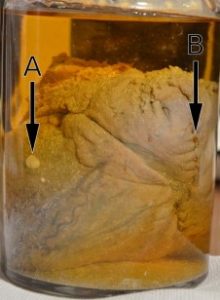History – 2018 (Section 2)
Sawicki GS, Fink AK, Schechter MS, Loeffler DR, Mayer-Hamblett N.Rate and predictors of prescription of lumacaftor – Ivacaftor in the 18 months following approval in the United States. J Cyst Fibros. 2018 Sep 7. pii: S1569-1993(18)30755-0. doi: 10.1016/j.jcf.2018.08.007. [Epub ahead of print] [Pubmed]

Fig.1 Gregory Sawicki X.com
Lumacaftor-ivacaftor (LUM-IVA) was approved in the US in 2015 for patients with CF aged >12 homozygous for the delF508 mutation, and patients aged 6 to 12 in 2016. The authors examined the rate of initial LUM-IVA prescriptions following approval. They compared patients eligible for LUM-IVA in the CF Foundation Patient Registry with and without prescriptions in 2015-2016.
5534 (53%) eligible patients had reported prescriptions. Prescription rate in children ages 6-11 was 19% and 61% among patients ≥12 years old. Individuals ≥12 with prescriptions more likely observed among those with private insurance, clinical trial participation, ages 18-30, FEV1 < 90%, more pulmonary exacerbations, and more use of chronic medications.
The authors concluded LUM-IVA uptake was less rapid than what was previously observed for ivacaftor, a CFTR modulator approved for a different population. Age, insurance status, disease severity and use of other therapies differed in those prescribed LUM-IVA in the initial post-approval period.
Gregory Sawicki (fig.1 ) is Director of the Cystic Fibrosis Center, Boston Children’s Hospital and Assistant Professor of Pediatrics, Harvard Medical School.
Schmidt M, Werbrouck A, Verhaeghe N, De Wachter E, Simoens S, Annemans L, Putman K. Strategies for newborn screening for cystic fibrosis: A systematic review of health economic evaluations. J Cyst Fibros. 2018 Mar 20. pii: S1569-1993(18)30072-9. doi: 10.1016/j.jcf.2018.03.002. [Epub ahead of print]

Fig.2 Masja Schmidt
ResearchGate
The objectives of this study are (1) to summarize study estimates of cost-effectiveness of cystic fibrosis newborn screening (CFNBS) strategies as compared to other strategies, (2) to assess the quality of the studies identified, and (3) to identify determinants of cost-effectiveness.
The evidence suggested that (i) all screening strategies are cost-effective as compared to the no-screening option and (ii) IRT-PAP seems to be the most cost-effective screening strategy towards CFNBS. Methodological and contextual differences of the individual studies make it difficult to derive strong conclusions from this evidence. Nevertheless, from a health-economic perspective, IRT-PAP should be included as an alternative when deciding on the screening.
Masja Schmidt (fig.2) is a scientific researcher at the Interuniversity Center for Health Economics Research, Vrije Universiteit Brussel, Brussels, Belgium
Schultz A, Caudri D. Cough swabs less useful but induced sputum very useful in symptomatic older children with cystic fibrosis. Lancet Respir Med. 2018 Jun;6(6):410-411. doi: 10.1016/S2213-2600(18)30183-8. Epub 2018 May 16.Full text [Pubmed]

Fig. 3 Andre Schultz
Infancy and the early preschool years comprise a vital period when structural changes in the lungs of people with cystic fibrosis begins. Therefore, while Ronchetti and colleagues (abstract above) provide robust evidence for the usefulness of sputum induction in symptomatic older children with cystic fibrosis, future efforts should be focused on developing an accurate non-invasive method for microbiological surveillance in young asymptomatic children. Only small numbers of children younger than 6 years were recruited, and the sample was too small to enable a separate analysis of children younger than 6 years. Also, for most samples taken in the part of the study comparing sputum induction with bronchoalveolar lavage, participants were symptomatic (ie, had respiratory exacerbations).
André Schultz (fig.3 ) is is a paediatric respiratory physician and the Director of Cystic Fibrosis at Perth Children’s Hospital.
Schwarz C, Brandt C, Whitaker P, Sutharsan S, Skopnik H, Gartner S, Smazny C, Röhmel JF. Invasive Pulmonary Fungal Infections in Cystic Fibrosis. Mycopathologia. 2018 Feb;183(1):33-43. doi: 10.1007/s11046-017-0199-4. Epub 2017 Sep 1. [Pubmed]

Fig. 4 Carsten Schwarz
Researchgate
Pulmonary mycosis is after allergic bronchopulmonary aspergillosis (ABPA) a frequent and severe complication of CF lung disease. Among CF caregivers, there is an insecurity when and how to treat infections of the lung parenchyma caused by different fungi in patients with CF. This case series provides a multicenter experience on diagnostic, manifestation, and treatment of non-ABPA cases of pulmonary. Non-ABPA cases of pulmonary mycoses in patients with CF have been collected from the CF Centers in Berlin, Essen, Worms, Frankfurt (Germany), Leeds (UK), and Barcelona (Spain). Non-ABPA was defined as total serum IgE level <500 kU/L. Scedosporium and Lomentospora species seem to be more virulent in patients with CF and have been successfully treated with triple antifungal drug regimens in several cases. Rare fungi including yeasts can have pathogenic potential in CF. In this series, antibiotic treatment failure was the main indicator for the initiation of antifungal treatment. For an early and effective treatment of pulmonary mycoses in CF, the identification of biomarkers and of risk factors beyond antibiotic treatment failure is crucial and urgently needed. Furthermore, treatment efficacy studies are necessary for the different causative agents of these infections.
Carsten Schwarz (fig. 4) is Director of Charité – Universitätsmedizin Berlin, Corporate Member of Freie Universität Berlin, Humboldt-Universität zu Berlin, and Berlin Institute of Health, Berlin, Germany.
Saavedra MT, Quon BS, Faino A, Caceres SM, Poch KR, Sanders LA, Malcolm KC, Nichols DP, Sagel SD, Taylor-Cousar JL, Leach SM, Strand M, Nick JA.Whole Blood Gene Expression Profiling Predicts Severe Morbidity and Mortality in Cystic Fibrosis: A 5-Year Follow-Up Study. Ann Am Thorac Soc. 2018 May;15(5):589-598. doi: 10.1513/AnnalsATS.201707-527OC. [Pubmed]

Fig. 5 Milene Saavedra
Cystic fibrosis pulmonary exacerbations accelerate pulmonary decline and increase mortality. Previously, we identified a 10-gene leukocyte panel measured directly from whole blood, which indicates response to exacerbation treatment. We hypothesized that molecular characteristics of exacerbations could also predict future disease severit
The authors tested whether a 10-gene panel measured from whole blood could identify patient cohorts at increased risk for severe morbidity and mortality, beyond standard clinical measures. Transcript abundance for the 10-gene panel was measured from whole blood at the beginning of exacerbation treatment (n = 57). A hierarchical cluster analysis of subjects based on their gene expression was performed, yielding four molecular clusters. An analysis of cluster membership and outcomes incorporating an independent cohort (n = 21) was completed to evaluate robustness of cluster partitioning of genes to predict severe morbidity and mortality
The four molecular clusters were analyzed for differences in forced expiratory volume in 1 second, C-reactive protein, return to baseline forced expiratory volume in 1 second after treatment, time to next exacerbation, and time to morbidity or mortality events (defined as lung transplant referral, lung transplant, intensive care unit admission for respiratory insufficiency, or death). Clustering based on gene expression discriminated between patient groups with significant differences in forced expiratory volume in 1 second, admission frequency, and overall morbidity and mortality. At 5 years, all subjects in cluster 1 (very low risk) were alive and well, whereas 90% of subjects in cluster 4 (high risk) had suffered a major event (P = 0.0001). In multivariable analysis, the ability of gene expression to predict clinical outcomes remained significant, despite adjustment for forced expiratory volume in 1 second, sex, and admission frequency. The robustness of gene clustering to categorize patients appropriately in terms of clinical characteristics, and short- and long-term clinical outcomes, remained consistent, even when adding in a secondary population with significantly different clinical outcomes.
The authors suggest whole blood gene expression profiling allows molecular classification of acute pulmonary exacerbations, beyond standard clinical measures, providing a predictive tool for identifying subjects at increased risk for mortality and disease progression.
Dr Milene T Saavendra (fig.5 ) is Associate Professor and pulmonologist, Department of Medicine, University of Colorado, Denver.
See editorial below –
Edmondson C, Davies JC. Predicting the Future of Cystic Fibrosis Lung Disease: Gene Expression Holds Some of the Answers. Ann Am Thorac Soc. 2018 May;15(5):556-557. doi: 10.1513/AnnalsATS.201802-098ED. [Pubmed] ( an editorial relating to the above article In an editorial relating to the paper of Saavendra et al.)

Fig. 6 Claire Edmundson

Fig. 7 Jane Davies
The authors note that a predictive biomarker of pulmonary exacerbations (APE) would be very useful. They discuss work undertaken in this area by a number of groups. In 2013 some 78 blood based biomarkers had been explored – C-reactive protein being the only one used in clinical practice; even this had limitations. They note that Saavenra and colleagues identify 4 definite gene cluster groups at the start of an APE as described in their paper which it is hoped should provide additional information on outlook.
Dr. Claire Edmondson (Fig. 6) is a paediatric registrar at the Royal Brompton currently working for a PhD relating to digital monitoring of CF patients at home.
Professor Jane Davies(fig.7) is Senior Lecturer at Imperial College and Hon. Consultant in Paediatric Respiratory Medicine at The Royal Brompton, London. She is a leading UK authority on cystic fibrosis and a senior member of the UK Gene Therapy Consortium.
Singh A, Ralhan A, Schwarz C, Hartl D, Hector A. Fungal Pathogens in CF Airways: Leave or Treat? Mycopathologia. 2018 Feb;183(1):119-137. doi: 10.1007/s11046-017-0184-y. Epub 2017 Aug 2.[Pubmed]

Fig. 8 Anurag Singh
Google Scholar
Fungi are frequently detected in CF airways and there is an increasing body of evidence that fungal pathogens might play a role in CF lung disease. Several studies have shown an association of fungi, particularly Aspergillus fumigatus and Candida albicans, with the course of lung disease in CF patients. It remains elusive whether fungi are actively involved in CF lung disease pathologies or whether they rather reflect a dysregulated airway colonization and act as microbial bystanders. A key issue for dissecting the role of fungi in CF lung disease is the distinction of dynamic fungal-host interaction entities, namely colonization, sensitization or infection. This review summarizes key findings on pathophysiological mechanisms and the clinical impact of fungi in CF lung disease.
– An extensively referenced review of the problem (222 references) relating to inhaled antibiotics and fungal infections.
Dr Anurag Singh (fig.8) is a scientist in the Department of Pediatrics, Pediatric Infectiology, Immunology and Cystic Fibrosis, Children’s Hospital, University of Tübingen, Hoppe-Seyler-Str. 1, 72076, Tübingen, Germany.
Schneider EK, McQuade RM, Carbone VC, Reyes-Ortega F, Wilson JW, Button B, Saito A, Poole DP, Hoyer D, Li J, Velkov T. The potentially beneficial central nervous system activity profile of ivacaftor and its metabolites. ERJ Open Res. 2018 Mar 13;4(1). pii: 00127-2017. doi: 10.1183/23120541.00127-2017. eCollection 2018 Jan. Free PMC Article [Pubmed]

Fig.9 Elena K Schneider
Ivacaftor-lumacaftor and ivacaftor are two new breakthrough cystic fibrosis transmembrane conductance modulators. The interactions of ivacaftor and its two metabolites hydroxymethylivacaftor (iva-M1) and ivacaftorcarboxylate (iva-M6) with neurotransmitter receptors were investigated in radioligand binding assays. Ivacaftor displayed significant affinity to the 5-hydroxytryptamine (5-HT; serotonin) 5-HT2C receptor (pKi=6.06±0.03), β3-adrenergic receptor (pKi=5.71±0.07), δ-opioid receptor (pKi=5.59±0.06) and the dopamine transporter (pKi=5.50±0.20); iva-M1 displayed significant affinity to the 5-HT2C receptor (pKi=5.81±0.04) and the muscarinic M3 receptor (pKi=5.70±0.10); iva-M6 displayed significant affinity to the 5-HT2A receptor (pKi=7.33±0.05). The in vivo central nervous system activity of ivacaftor (40 mg·kg-1 intraperitoneally for 21 days) was assessed in a chronic mouse model of depression. In the forced swim test, the ivacaftor-treated group displayed decreased immobility (52.8±7.6 s), similarly to fluoxetine (33.8±11.0 s), and increased climbing/swimming activity (181.5±9.2 s). In the open field test, ivacaftor produced higher locomotor activity than the fluoxetine group, measured both as mean number of paw touches (ivacaftor 81.1±9.6 versusfluoxetine 57.9±9.5) and total distance travelled (ivacaftor 120.6±16.8 cm versus fluoxetine 84.5±16.0 cm) in 600 s. Treatment of 23 cystic fibrosis patients with ivacaftor-lumacaftor resulted in significant improvements in quality of life (including anxiety) in all five domains of the AweScoreCF questionnaire (p=0.092-0.096). Our findings suggest ivacaftor displays potential clinical anxiolytic and stimulating properties, and may have beneficial effects on mood.
— For those (like this writer) unfamiliar with the Forced Swim test. In this assay mice are placed in a cylinder filled with water from which they cannot escape. After a few minutes the mice will stop trying to escape and will simply float in the water, only making swimming movements sufficient to stay afloat. This immobility response has been interpreted as a “depressed” state and research has shown that immobility is decreased by antidepressant drugs like imipramine (Tofranil, a tricyclic) and fluoxetine (Prozac, a selective serotonin reuptake inhibitor), but not drugs that belong to other therapeutic classifications (e.g. antianxiety drugs). Thus, this preclinical behavioral assay has a high reliability for identifying drugs that have antidepressant properties in humans and it can be used to understand the similarities and differences among the various drugs that have been and are currently being developed for the treatment of depression.
– The behaviour of these mice is taken as evidence that ivacaftor has a definite effect on the central nervous system.
Dr Elena Katharine Schneider (fig. 9) is a research Fellow in Microbiology at Monash University
Schwarz C, Hartl D, Eickmeier O, Hector A, Benden C, Durieu I, Sole A, Gartner S, Milla CE, Barry PJ.Progress in Definition, Prevention and Treatment of Fungal Infections in Cystic Fibrosis. Mycopathologia. 2018 Feb;183(1):21-32. doi: 10.1007/s11046-017-0182-0. Epub 2017 Jul 31. [Pubmed]
The main bacterial species causing infections include Pseudomonas aeruginosa, Staphylococcus aureus, Haemophilus influenzae and Achromobacter xylosoxidans. In addition to bacteria, fungi are detected in a significant number of patients. Although fungal infections are rare, fungi can cause severe pneumonia requiring appropriate targeted treatment. The most common fungi in respiratory samples of patients with CF are Aspergillus fumigatus, Aspergillus terreus and Scedosporium species for filamentous fungi, and yeasts such as Candida albicans and Candida glabrata. Therapeutic strategies depend on the detected fungus and the underlying clinical status of the patient. The antifungal therapy can range from a simple monotherapy up to a combination of three different drugs. Treatment course may be indicated in some patients for two weeks and in others for up to six months, and in rare cases even longer. New antifungal drugs have been developed and are being tested in clinical studies offering the hope of therapeutic alternatives to existing drugs. Identifying relevant risk factors and diagnostic criteria for fungal colonization and infection is crucial to enabling an adequate prevention, diagnosis and treatment.
Carsten Schwarz (Fig.4 above) is Director of Charité – Universitätsmedizin Berlin, Corporate Member of Freie Universität Berlin, Humboldt-Universität zu Berlin, and Berlin Institute of Health, Berlin, Germany.
Schwarz C, Brandt C, Melichar V, Runge C, Heuer E, Sahly H, Schebek M, Köster H, Bouchara JP, Biedermann T, Meißner P, Große-Onnebrink J, Skopnik H, Hartl D, Sedlacek L, Tintelnot K. Combined antifungal therapy is superior to monotherapy in pulmonary scedosporiosis in cystic fibrosis. J Cyst Fibros. 2018 Oct 5. pii: S1569-1993(18)30794-X. doi: 10.1016/j.jcf.2018.08.012. [Epub ahead of print] [Pubmed]
Moulds belonging to the genus Scedosporium/Lomentospora are detected most frequently in respiratory samples of patients with CF, next to Aspergillus spp. The authors aimed to define pulmonary fungal infections due to Scedosporium/Lomentospora in CF and to study the antimycotic treatment. In this multicentre study (12 centres; duration January 2008 to December 2014) 31 patients with a lung infection caused by moulds of the genus Scedosporium/Lomentospora were included. 36 courses of antifungal treatment were documented. Scedosporium apiospermum sensu stricto accounted for 48.4% of cases. In 20/31 patients a therapeutic response under antimycotics (median duration 3.9 months) was achieved. Triple and double therapy was significantly more effective compared to monotherapy regarding FEV1, radiology, and symptoms. This data suggests that combined treatment is superior to monotherapy in patients with CF.
– Useful combined experience for those treating these relatively uncommon infections.
Siracusa CM, Ryan J, Burns L, Wang Y4 Zhang N, Clancy JP, Drotar D. Electronic monitoring reveals highly variable adherence patterns in patients prescribed ivacaftor. J Cyst Fibros. 2015 Sep;14(5):621-6. doi: 10.1016/j.jcf.2015.05.009. Epub 2015 Jun 11. [Pubmed] Free PMC Article

Fig.10 Christopher Siracusa Cincinatti Children’s Hospital
Previous studies of CF treatments have shown suboptimal adherence, though little has been reported regarding adherence. 12 subjects (age 6-48 years; CFTR-G551D mutation) previously prescribed ivacaftor were monitored for a mean of 118 days. Overall adherence by EM was 61% (SD=28%) and decreased over time. Median duration between doses was 16.9 hours (IQR 13.9-24.1 hours) and increased over time. There was no correlation between EM-derived adherence and either refill history (84%, r=0.26, p=0.42) or self-report (100%, r=0.40, p=0.22).
Despite the promising nature of ivacaftor, the authors consider their data suggest adherence rates are suboptimal and comparable to other prescribed CF therapies, and more commonly used assessments of adherence may be unreliable.
Dr Christopher Siracusa (fig.10) is Associate Director of the Cystic Fibrosis Center, Cincinnati Children’s Hospital
— Although aware that adherence rates to treatment in people with CF are often poor, and the addition of ivacaftor is yet another treatment, it is a surprise that adherence is so poor with a treatment that has such obvious and immediate benefit. This is a detailed review of the important subject of adherence in CF and other chronic conditions.
Spoletini G, Kennedy M, Flint L, Graham T, Etherington C, Shaw N, Whitaker P, Denton M, Clifton I, Peckham D. Intravenous fosfomycin for pulmonary exacerbation of cystic fibrosis: Real life experience of a large adult CF centre.Pulm Pharmacol Ther. 2018 Apr 13. pii: S1094-5539(17)30305-X. doi: 10.1016/j.pupt.2018.04.007. [Epub ahead of print] [Pubmed]

Fig. 11 Giulia Spoletini
A study to describe the clinical efficacy, safety and tolerability of intravenous fosfomycin in combination with a second anti-pseudomonal antibiotic to treat pulmonary exacerbations in adult patients with CF.
A retrospective analysis of data captured prospectively. 54 patients received 128 courses of iv fosfomycin in combination with a second antibiotic, resulting in improved FEV1 (0.94 L vs 1.24 L, p < 0.01) and reduced CRP (65 mg/L vs 19.3 mg/L, p < 0.01). Renal function pre- and post-treatment remained stable. 4% (n = 5) of courses were complicated with AKI at mid treatment, which resolved at the end of the course. Electrolyte supplementation was required in 18% of cases for potassium and magnesium and 7% for phosphate. Nausea was the most common side effects (48%), but was well controlled with anti-emetics
Antibiotic regimens including fosfomycin appear to be clinically effective and safe. Fosfomycin should, therefore, be considered as an add-on therapy in patients who failed to respond to initial treatment and with multiple drug allergies.
Dr.Giulia Spoletini (fig 11) is a Clinical Research Fellow, subsequently consultant physician, in Leeds Teaching Hospitals Adult CF Centre at St James University Hospital.
Stahl M, Wielpütz MO, Ricklefs I, Dopfer C, Barth S, Schlegtendal A, Graeber SY, Sommerburg O, Diekmann G, Hüsing J, Koerner-Rettberg C, Nährlich L, Dittrich AM, Kopp MV, Mall MA. Preventive Inhalation of Hypertonic Saline in Infants with Cystic Fibrosis (PRESIS): A Randomized, Double-Blind, Controlled Study.Am J Respir Crit Care Med. 2018 Nov 9. doi: 10.1164/rccm.201807-1203OC. [Epub ahead of print] [Pubmed]

Fig. 12 Mirjam Stahl
Cystic fibrosis (CF) lung disease starts in early infancy suggesting that preventive treatment may be most beneficial. Lung clearance index (LCI) and chest magnetic resonance imaging (MRI) have emerged as promising endpoints of early CF lung disease, however, randomized controlled trials testing the safety and efficacy of preventive therapies in infants with CF are lacking. This study was to determine feasibility, safety and efficacy of preventive inhalation with hypertonic saline (HS) compared to isotonic saline (IS) in infants with CF including LCI and MRI as outcome measures.
In this randomized, double-blind, controlled trial 42 infants with CF less than 4 months of age were randomized across 5 sites to twice daily inhalation of 6% HS (n=21) or 0.9% IS (n=21) for 52 weeks. Inhalation of HS and IS was generally well tolerated by CF infants and the number of adverse events did not differ between groups (P=0.49). The change in LCI from baseline to week 52 was larger in CF infants treated with HS (-0.6) compared to IS (-0.1, P<0.05). In addition, weight gain was improved in CF infants treated with HS (P<0.05), whereas pulmonary exacerbations and chest MRI scores did not differ in the HS vs. IS group.
The authors concluded preventive inhalation with HS initiated in the first months of life was safe and well tolerated, and resulted in improvements in LCI and weight gain in infants with CF. Their results support feasibility of LCI as endpoint in randomized controlled trials in infants with CF..
Dr Mirjam Stahl (fig.12) from the Division of Pediatric Pulmonology & Allergy and Cystic Fibrosis Centre, Department of Pediatrics and Department of Translational Pulmonology, Translational Lung Research Centre, Heidelberg (TLRC).
Stallings VA, Sainath N, Oberle M, Bertolaso C, Schall JI. Energy Balance and Mechanisms of Weight Gain with Ivacaftor Treatment of Cystic FibrosisGating Mutations. J Pediatr. 2018 Oct;201:229-237.e4. doi: 10.1016/j.jpeds.2018.05.018. Epub 2018 Jul 18. [Pubmed]

Fig.13 Virginia Stallings. pcom.edu
A study to determine if ivacaftor treatment results in weight gain and improved pulmonary function in people with cystic fibrosis transmembrane conductance regulator gating mutations. Children and adults with cystic fibrosis and at least 1 cystic fibrosis transmembrane conductance regulator gating mutation were evaluated in this observational study before and after 3 months of ivacaftor treatment. Body size and composition, total energy expenditure, resting energy expenditure (REE%) as percent predicted, coefficient of fat absorption (CFA%), fecal calprotectin, fecal elastase, and quality of life were assessed. Some outcomes were explored by pancreatic status.
There were 23 patients (5-61 years of age) who completed the study; 70% had pancreatic insufficiency (PI). Patients gained 2.5 ± 2.2 kg (P < .001) with increased (P < .05) fat-free mass (0.9 ± 1.9 kg) and fat mass (1.6 ± 1.5 kg). REE% decreased by 5.5 ± 12.0% (P < .05), fecal calprotectin decreased by 30 ± 40 µg/g stool (P < .01), and total energy expenditure was unchanged. Improvements were greater for PI than patients who were pancreatic-sufficient. CFA% increased significantly only with PI. The change (Δ) in weight was positively correlated with the percent change in forced expiratory volume at 1 second (r = 0.46; P = .028) and ΔCFA% (r = 0.47; P = .032) and negatively with ΔREE% (r = -0.50; P = .017). Together, ΔREE%, ΔCFA%, and the percent change in forced expiratory volume at 1 second explained 58% of the variance in weight gain (adjusted R2 = 0.579; P = .0007). Growth status and muscle strength improved, as did quality of life in several domains. Fecal elastase increased in most patients with pancreatic sufficiency, with no change in those with PI.
The authors identified mechanisms for ivacaftor-associated weight gain were decreased resting energy expenditure, gut inflammation, and fat malabsorption.
Dr Virginia A Stallings (fig.13) is a nutrition paediatrician and the Jean A. Cortner Endowed Chair in the Division of Gastroenterology, Hepatology and Nutrition at Children’s Hospital of Philadelphia. She is the Research Director in the Nutrition Center.
Thomassen JC, Mueller MI, Alejandre Alcazar MA, Rietschel E, van Koningsbruggen-Rietschel S. Effect of Lumacaftor/Ivacaftor on glucose metabolism and insulin secretion in Phe508del homozygous cystic fibrosis patients.
J Cyst Fibros. 2018 Mar;17(2):271-275. doi: 10.1016/j.jcf.2017.11.016. Epub 2017 Dec 15. [Pubmed]

Fig. 14 Silke van Koningsbruggen
A study to investigate the effect of Lumacaftor/Ivacaftor [Orkambi] on glucose metabolism and insulin secretion in patients with cystic fibrosis(CF) (Phe508del/Phe508del). A standard oral glucose tolerance test (OGTT) and an intravenous glucose tolerance test (IVGTT) were performed to investigate glucose metabolism and insulin secretion before and after 6-8weeks of treatment with Lumacaftor/Ivacaftor in 5 Phe508del-homozygous CF patients. The area under the curve (AUC) for glucose and insulin levels was calculated using the trapezoidal approximation. 5 participants were investigated.
Treatment with Lumacaftor/Ivacaftor was followed by an improvement of the 2h glucose levels in 3 patients and worsening in 2 patients. Analysis of the time course of blood glucose levels during OGTT revealed an increase of the AUC in 3 of 5 patients. In response to IVGTT, acute insulin secretion improved in 2 patients and worsened in three.
The authors concluded their investigation could not demonstrate that treatment with Lumacaftor/Ivacaftor had a consistent impact on glucose tolerance and insulin secretion. They suggested further adequately-powered studies examining glucose metabolism are needed.
Dr Silke van Koningsbruggen (fig.14) is at the Cystic Fibrosis Center University Hospital Cologne.
Thursfield RM, Naderi K, Leaver N, Rosenthal M, Alton EWFW, Bush A, Davies JC. Children with cystic fibrosis demonstrate no respiratory immunological, infective or physiological, consequences of vitamin D deficiency. J Cyst Fibros. 2018Apr 6. pii: S1569-1993(18)30070-5. doi: 10.1016/j.jcf.2018.02.011. [Epub ahead of print] [Pubmed]
Vitamin D has health benefits in many respiratory diseases but the evidence in CF is unclear. Induction of the antimicrobial peptides cathelicidin (LL37) and human-beta-defensin-2 (HBD-2) may be the mechanism of any benefit. The authors hypothesised that antimicrobial peptide levels would be decreased, and airway infection and inflammation greater, in CF children with vitamin D deficiency. The objective of the study was to explore relationships between vitamin D, LL37 and HBD-2, and airway infection, inflammation and physiology in children with CF.
Bronchoalveolar lavage (BALF) and blood were obtained from children undergoing fibreoptic bronchoscopy. 113 patients with CF, 23 with non-CF chronic suppurative lung disease (CSLD) and 6 healthy controls were included. They found no relationship between serum vitamin D and BALF HBD-2 or LL-37. There were no differences in infective or inflammatory markers between vitamin D sufficient and deficient groups. Vitamin D deficient patients (<50 nmol/L) did not have a worse FEV1 (CF: 66 (58-71)% vs. 71.5 (61-76)%, ns; non-CF CSLD: 69 (36-88)% vs. 70 (62-95)%, ns).
So the authors concluded from this, the first bronchoscopy study exploring this question, that vitamin D deficiency is not associated with immunological, infective or clinical markers of disease severity in patients with CF or CSLD.
Rebecca M Thursfield from the National Heart and Lung Institute, Imperial College, London, United kingdom; Department of Paediatric Respiratory Medicine, Royal Brompton & Harefield NHS Foundation Trust, London, United Kingdom. Usually Respiratory Consultant at Alder Hey Children’s Hospital, Liverpool, UK
Tomati V, Caci E, Ferrera L, Pesce E, Sondo E, Cholon DM, Quinney NL, Boyles SE, Armirotti A, Ravazzolo R, Galietta LJ, Gentzsch M , Pedemonte N. Thymosin α-1 does not correct F508del-CFTR in cystic fibrosis airway epithelia. JCI Insight. 2018 Feb 8;3(3). pii: 98699. doi: 10.1172/jci.insight.98699. [Epub ahead of print] Free full text.[Pubmed]
Recently beneficial effects that could lead to a single-molecule-based therapy for CF patients with F508del. Such effects include suppression of inflammation, improvement in F508del-CFTR maturation and gating, and stimulation of chloride secretion through the calcium-activated chloride channel (CaCC). Given the importance of such a drug, the authors aimed to characterize the underlying molecular mechanisms of action of Tα-1. In-depth analysis of Tα-1 effects was performed using well-established microfluorimetric, biochemical, and electrophysiological techniques on epithelial cell lines and primary bronchial epithelial cells from CF patients. The studies, which were conducted in 2 independent laboratories with identical outcome, demonstrated that Tα-1 is devoid of activity on mutant CFTR as well as on CaCC. Although Tα-1 may still be useful as an anti-inflammatory agent, its ability to target defective anion transport in CF remains to be further investigated.

Fig. 15 Nicoletta Pedemonte

Fig. 16 Loretta Ferrera

Fig. 17 Valeria Tomati
Nicoletta Pedemonte (fig.15) currently works at the U.O.C. Genetica Medica, IRCCS Istituto G. Gaslini. Their current project is ‘CFTR modulators.
Loretta Ferrera (fig.16) and Valerie Tomati (fig.17) currently work at the U.O.C. Genetica Medica, IRCCS Istituto G. Gaslini.
— These studies fail to confirm the recent publication of Romani et al. Nat Med 2017 May; 23(5):590-600. [Pubmed] indicating that thymosin a-1 can correct F508del-CFTR. The Romani et al paper is described in the 2017 section of this history.
Trimble AT, Donaldson SH. Ivacaftor withdrawal syndrome in cystic fibrosis patients with the G551D mutation. J Cyst Fibros. 2018 Mar;17(2):e13-e16. doi: 10.1016/j.jcf.2017.09.006. Epub 2017 Oct 24. [Pubmed]

Fig. 18 Aaron Trimble NACFC
Ivacaftor use can lead to dramatic health improvements in cystic fibrosis (CF) patients with gating mutations. Here, we report five instances of dramatic clinical decline following withdrawal of ivacaftor in three individuals with the G551D-CFTR mutation. In each case, the patient’s lung function and symptoms rapidly deteriorated after cessation of treatment. Awareness of this phenomenon should inform both clinical practices as well as the design of future clinical trials of highly active CFTR modulators.
Aaron Trimble (fig. 18) is professor in Division of Pulmonary & Critical Care Medicine, Division of Medicine, University of North Carolina School of Medicine, Chapel Hill, NC, United States.
Trimble AT, Whitney Brown A, Laube BL, Lechtzin N, Zeman KL, Wu J, Ceppe A, Waltz D, Bennett WD, Donaldson SH. Hypertonic saline has a prolonged effect on mucociliary clearance in adults with cystic fibrosis. J Cyst Fibros. 2018 Jan 19. pii: S1569-1993(18)30004-3. doi: 10.1016/j.jcf.2018.01.001. [Epub ahead of print] [Pubmed]
In a large study of young children with CF inhaled hypertonic saline (HS) failed to demonstrate clinical benefits. These authors previously reported the absence of a sustained effect of HS on mucociliary clearance (MCC) in healthy adults and in this study sought to characterize the durability of the MCC response to HS in adults with CF using gamma scintigraphy.
The authors showed that, in contrast to healthy adults, a single dose of HS has a prolonged effect on MCC in adults with CF, which lasts at least 4 h. This may explain its clinical efficacy in this population.
Dr. Aaron Trimble (fig.18 above) is a professor and pulmonologist in Chapel Hill, North Carolina, and affiliated with the University of North Carolina.
Van der Plas SE, Kelgtermans H, De Munck T, Martina SLX, Dropsit S, Quinton E, De Blieck A, Joannesse C, Tomaskovic L, Jans M, Christophe T, van der Aar E, Borgonovi M, Nelles L, Gees M, Stouten P, Van Der Schueren J, Mammoliti O, Conrath K, Andrews M. Discovery of N-(3-Carbamoyl-5,5,7,7-tetramethyl-5,7-dihydro-4H-thieno[2,3-c]pyran-2-yl)-lH-pyrazole-5-carboxamide (GLPG1837), a Novel Potentiator Which Can Open Class III Mutant Cystic Fibrosis Transmembrane Conductance Regulator (CFTR) Channels to a High Extent. J Med Chem. 2018 Jan 10. doi: 10.1021/acs.jmedchem.7b01288. [Epub ahead of print] [Pubmed]

Fig. 19 Steven Van der Plas
ResearchGate
With the discovery of Ivacaftor and Orkambi, it has been shown that CFTR function can be partially restored by administering one or more small molecules. These molecules aim at either enhancing the amount of CFTR on the cell surface (correctors) or at improving the gating function of the CFTR channel (potentiators).
Here the authors describe the discovery of a novel potentiator GLPG1837, which shows enhanced efficacy on CFTR mutants harbouring class III mutations compared to Ivacaftor, the first marketed potentiator.
Steven E Van der Plas (fig.19) is Director of Medicinal Chemistry, Generaal De Wittelaan L11 A3, 2800 Mechelen, Belgium.
Waters V, Grimwood K. Defining chronic Pseudomonas aeruginosa infection in cystic fibrosis. J Cyst Fibros. 2018 Mar 27. pii: S1569-1993(18)30079-1. doi: 10.1016/j.jcf.2018.03.007. [Epub ahead of print] [Pubmed]

Fig. 20 Valerie Waters CF Medicine
Review of the studies of Heltshe et al and Boutin et al. aim to redefine what chronic P. aeruginosa infection means in CF. It is clear, though, that mucoid P. aeruginosa does have an adaptive advantage in early CF infection as mucoidy was associated with an almost three-fold increased risk of transition to chronic infection in this current study. Despite the presence of this risk factor, however, only 13% of P. aeruginosa infected patients went on to develop chronic infection. Although Heltshe et al. did not provide details as to eradication strategies used in this cohort, this low incidence of persistent infection does speak to the overall effectiveness of current antimicrobial treatment for early P. aeruginosa infection.
— Boutin et al. took their investigation a step further by using molecular methods, specifically quantitative polymerase chain reaction (qPCR), to define chronic P. aeruginosa infection. Performing P. aeruginosa qPCR on culture negative throat swabs may further improve the diagnosis of lower airway infection in young children with CF who are unable to produce sputum.
Valerie Waters is in the Division of Infectious Diseases, Department of Pediatrics, Hospital for Sick Children, University of Toronto, Toronto, Canada.
THE FOLLOWING FOUR RECENT ABSTRACTS CONCERN CHOPIN’S HEART AND SO ARE PLACED TOGETHER
Witt M, Szklener A, Kawecki J, Rużyłło W, Negrusz-Kawecka M, Jeleń M, Langfort R, Marchwica W, Dobosz T. A Closer Look at Frederic Chopin’s Cause of Death. Am J Med. 2018 Feb;131(2):211-212. doi: 10.1016/j.amjmed.2017.09.039. Epub 2017 Oct 12. [Pubmed]

Fig. 21 Michal Witt
On the basis of visual analysis of Chopin’s heart the authors concluded that he died from long lasting tuberculosis as the primary disease causing progressive deterioration his physical condition. Tuberculous pericarditis progressing rapidly may have been the cause of death.

Fig. 22 Chopin’s heart
Prof. Michael Witt (fig.21) has been head of the Division of Molecular and Clinical Genetics, Institute of Human Genetics, Polish Academy of Sciences for many years. Since 1999 Deputy Director at the International Institute of Molecular and Cell Biology Warsaw.
Professor Witt told the Observer “Some people still want to open it (the jar) in order to take tissue samples to do DNA tests to support their ideas that Chopin had some kind of genetic condition. Witt said.”That would be absolutely wrong. It could destroy the heart and in any case I am quite sure we now know what killed Chopin.”
Perciaccante A, Charlier P, Negri C, Coralli A, Appenzeller O, Bianucci R. Did Frédéric Chopin Die From Heart Failure?J Card Fail. 2018 Mar 26. pii: S1071-9164(18)30122-2. doi: 10.1016/j.cardfail.2018.03.009. [Epub ahead of print] [Pubmed]

Fig. 23 Antonio Perciaccante
On October 17, 1849, Poland’s greatest composer, Frédéric Chopin (1810-1849) died aged 39. His cause of death remains unknown. An investigation of the documental sources was performed to reconstruct the medical history of the artist. Since his earliest years, his life had been dominated by poor health. Recurrent episodes of cough, fever, headaches, lymphadenopathy- a series of symptoms that may be attributed to viral respiratory infections- manifested in his teens. Later in life, he had chest pain, haemoptysis, hematemesis, neuralgia, and arthralgia. Exhaustion and breathlessness characterized all his adult life. Coughing, choking, and oedema of the legs and ankles manifested four months before his death. Several hypotheses ranging from cystic fibrosis to alpha-1 anti-trypsin deficiency and pulmonary tuberculosis have been proposed to explain Chopin’s lifelong illness.
These authors suggest that Chopin had dilated cardiomyopathy with consequent heart failure and cirrhosis that caused his death..
Antonio Perciaccante (fig.23) is from the Department of Medicine San Giovanni di Dio Hospital, Gorizia, Italy
Charlier P, Perciaccante A, Herbin M, Appenzeller O, Bianucci R. The Heart of Frederic Chopin (1810-1849).Am J Med. 2018 Apr;131(4):e173-e174. doi: 10.1016/j.amjmed.2017.12.005. [Pubmed]

Fig.24 Phillipe Charlier
The authors are critical of the conclusions in the paper of Witt et al 2017 where tuberculous (TB) pericarditis coupled with massive enlargement of the right ventricle, possibly due to pulmonary hypertension, was proposed as the most plausible cause of death of the artist based on three nodules not examined histologically. They consider a retrospective diagnosis of TB pericarditis cannot be made with confidence.
Philippe Charlier (fig.24) is Head of the Section of Medical and a Forensic Anthropology, Université de Versailles Saint-Quentin. An article in the New York Times states that Dr. Charlier “does not confine himself to his closet of a laboratory at the hospital here. He writes books, makes television documentaries and does radio broadcasts to popularize his findings, which has earned him the title of “Indiana Jones of the graveyards.”
There is a vast amount of information on the internet regarding Chopin’s heart, ill health and death.
Duclos-Vallée JC, Erlinger S. Is Frederic Chopin’s Death Elucidated? Am J Med. 2018 Apr;131(4):e171. doi: 10.1016/j.amjmed.2017.11.041. No abstract available pubmed.ncbi.nlm.nih.gov/?term=Erlinger+S+2018&sort=date&size=200

Jean Charles Duclos Vallee Doctolib
These authors consider that clinical presentation of Chopin’s chronic disease is not typical of tuberculosis as there appeared to be complete recovery between episodes of respiratory illness. Also he had been examined by Laennec who did not diagnose tuberculosis. The authors mention other hypotheses including a1-antitrypsin deficiency for which there a reasonable case. As the original autopsy report of Prof. Jean Cruveilhier was lost the article of Witt et al brings important new information to the immediate cause of Chopin’s death. Apparently Cruveilhier pulled out the heart, which was then transported to Warsaw by Chopin’s sister.
These authors “think more data would be useful specifically a genetic analysis to exclude or confirm once and for all the diagnosis of a1- antitrypsin deficiency”.
Jean Charles Duclos Vallee (fig 25) is Professor of Hepatology at the Centre Hépato-Biliaire, Paul-Brousse Hospital, Villejuif, Paris–Saclay University, France.
Vadagam P, Kamal KM, Covvey JR, Giannetti V, Mukherjee K. Cost-Effectiveness and Budget Impact of Lumacaftor/Ivacaftor in the Treatment of Cystic Fibrosis. J Manag Care Spec Pharm. 2018 Oct;24(10):987-997. doi: 10.18553/jmcp.2018.24.10.987. Free full text [Pubmed]

Fig. 26 Pratyusha Vadagam
LinkedIn
A cost-effectiveness analysis (CEA) of lumacaftor/ivacaftor (Orkambi) to understand the overall effectiveness of the drug compared with its costs and (b) conduct a budget impact analysis (BIA) to understand the potential financial effect of introducing a new drug in a health plan. The annual cost of therapy per patient for lumacaftor/ivacaftor was $379,780. The ACER for lumacaftor/ivacaftor was $151,912, while the ICER for lumacaftor/ivacaftor compared with placebo was $95,016 per FEV1% predicted. The annual total budget impact due to the inclusion of lumacaftor/ivacaftor on the health plan formulary was $266,046. In patients with CF, lumacaftor/ivacaftor (Orkambi) has demonstrated better clinical effectiveness compared with placebo alongside an increased drug acquisition cost. However, the therapy may be a viable alternative to existing standard therapy over a short time horizon. Health care payers, both private and public, need to evaluate the cost-effectiveness and the financial effect when considering expansion of new drug coverage in CF management.
– More details in the PubMed abstract and free Full text
Pratyusha Vadagam (fig.26) is a manager and pharmacoeconomic modeller in the Division of Pharmaceutical, Administrative and Social Sciences, Duquesne University School of Pharmacy, Pittsburgh, Pennsylvania.
Van Biervliet S, Declercq D, Somerset S.Clinical effects of probiotics in cystic fibrosis patients: A systematic review. Clin Nutr ESPEN. 2017 Apr;18:37-43. doi: 10.1016/j.clnesp.2017.01.007. Epub 2017 Feb 22. [Pubmed]
This study investigated the current evidence for probiotics as an adjunct to usual therapy for CF. Electronic clinical databases were interrogated for human randomised, controlled, intervention trials (1985-2015) testing the effects of probiotics on clinical endpoints in CF were reviewed. From 191 articles identified in initial searches, six studies met the critical inclusion criteria, and were reviewed in detail. These studies varied in size (n = 22 to 61) but were generally small and showed substantial diversity in protocol, specific probiotic species used and range of clinical outcomes measured. Probiotic administration showed beneficial effects on fecal calprotectin levels, pulmonary exacerbation risk, and quality of life indicators. In one study, such changes were associated with variations in gut microbiota composition.
Despite encouraging preliminary results, the limited number of small and highly varied studies to date do not justify the addition of probiotics as an adjunct to current CF treatment protocols. Importantly, very minimal adverse effects of probiotics have been reported
Van Biervliet S, Hauser B, Verhulst S, Stepman H, DelangheJ, Warzee JP, Pot B, Vandewiele T, Wilschanski M.Probiotics in cystic fibrosis patients: A double blind crossover placebo controlled study: Pilot study from the ESPGHAN Working Group on Pancreas/CF. Clin Nutr ESPEN. 2018 Oct;27:59-65. doi: 10.1016/j.clnesp.2018.06.008. Epub 2018 Jul 20 [Pubmed]

Fig. 27 Stephanie Van Biervliet
A potential positive effect of probiotics in cystic fibrosis (CF) on fecal calprotectin (FCP), pulmonary exacerbations and weight has been described in small controlled trials. A double-blind multicenter cross-over study (2 × 4 m) was performed looking at abdominal pain, nutritional status, pulmonary function, pulmonary exacerbation, FCP and lactulose/mannitol gut permeability test. Patients kept a diary with daily scoring of abdominal pain, stool frequency and consistency as well as treatment changes.
31 CF patients entered the study of which 25 finished it. At start patients aged 9.3yrs (6.9-12.2), had a median BMI z-score of -0.5 (-1.5-0.08), height z-score of -0.4 (-1.1-0.05) and FEV1% of 100% (87.2-106.6). Median FCP at start was 61 μg/g (17-108) and gut permeability 0.079 (0.051-0.122). No significant changes were observed in the clinical parameters (BMI, FEV1%, abdominal pain, exacerbations). Despite being frequently abnormal (17/28 (61%) >50 mg/kg), FCP did not change significantly with probiotics. The proportion of patients with normal permeability was 8% during placebo and 32% during probiotic treatment (p = 0.031). FCP correlated to BMI z-score (p = 0.043) and gut permeability to abdominal pain (p = 0.015). The microbiome revealed a high predominance of Actinobacteria and Proteobacteriae. Probiotic supplementation did not result in a shift at the phylum nor at phylogenetic level.
The authors concluded that normalization of gut permeability was observed in 13% of patients during probiotic treatment. However, none of the previously described effects on fecal calprotectin (FCP), pulmonary exacerbations and weight, which have been described in previous small controlled trials, could be confirmed.
Prof.dr.Stephanie Van Biervliet (fig.27) works in the Department of Paediatrics and Medical Genetics, Ghent University Hospital, and is coordinator of the CF Centre.
van Horck M, van de Kant K Winkens B, Wesseling G, Gulmans V, Hendriks H, van der Grinten C, Jöbsis Q, Dompeling E. Risk factors for lung disease progression in children with cystic fibrosis. Eur Respir J. 2018 Jun 7;51(6). pii: 1702509. doi: 10.1183/13993003.02509-2017. Print 2018 Jun. [Pubmed]

Fig. 28 Marieke van Hock
LinkedIn
The authors studied the longitudinal data of all children with CF (aged ≥5 years) registered in the Dutch CF Registry (2009-2014). Lung disease progression was expressed as a decline in lung function (forced expiratory volume in 1 s (FEV1) % pred) and pulmonary exacerbation rate.
In a cohort of Dutch children with CF followed for 5 years, the authors were able to identify several risk factors for future exacerbations. In particular, the association between proton pump inhibitor use and lung disease progression definitely requires further investigation.
Marieke van Hock (fig.28) is in the Dept of Paediatric Respiratory Medicine, Care and Public Health Research Institute (CAPHRI), Maastricht University Medical Centre (MUMC+), Maastricht, The Netherlands.
van de Peppel IP, Doktorova M, Berkers G, de Jonge HR, Houwen RHJ, Verkade HJ, Jonker JW, Bodewes FAJA. IVACAFTOR restores FGF19 regulated bile acid homeostasis in cystic fibrosis patients with an S1251N or a G551D gating mutation. J Cyst Fibros. 2018 Sep 29. pii: S1569-1993(18)30799-9. doi: 10.1016/j.jcf.2018.09.001. [Epub ahead of print][Pubmed]

Fig.29 Ivo P van de Peppel
Disruption of the entero-hepatic circulation of bile acids (BAs) is part of the gastrointestinal phenotype of cystic fibrosis. The authors studied the effect of ivacaftor on the enterohepatic circulation by assessing markers of BA homeostasis and their changes in CF patients. In CF patients with an S1251N mutation (N = 16; age 9-35 years S125N study/NTR4873) or a G551D mutation (N = 101; age 10-24 years; GOAL study/ NCT01521338) they analyzed plasma fibroblast growth factor 19 (FGF19) and 7α-hydroxy-4-cholesten-3-one (C4) levels, surrogate markers for intestinal BA absorption and hepatic synthesis, respectively, before and after treatment with ivacaftor.
At baseline, median FGF19 was lower (52% and 53%, P < .001) and median C4 higher (350% and 364%, P < .001), respectively, for the S1251 N and G551D mutation patient groups compared to healthy controls. Treatment with ivacaftor significantly increased FGF19 and reduced C4 levels towards normalization in both cohorts but this did not correlate with CFTR function in other organs, as measured by sweat chloride levels or pulmonary function.
The authors demonstrated that patients with CFTR gating mutations display interruption of the enterohepatic circulation of BAs reflected by lower FGF19 and elevated C4 levels. Treatment with ivacaftor partially restored this disruption of BA homeostasis. The improvement did not correlate with established outcome measures of CF, suggesting involvement of modulating factors of CFTR correction in different organ
Ivo P van de Peppel (fig.29) works at the department of Molecular Metabolism and Nutrition, Department of Pediatrics, University of Groningen, Beatrix Children’s Hospital – University Medical Center Groningen
Villella VR, Venerando A, Cozza G, Esposito S, Ferrari E, Monzani R, Spinella MC, Oikonomou V, Renga G5 Tosco A, Rossin F, Guido S, Silano M, Garaci E, Chao YK, Grimm C, Luciani A, Romani L, Piacentini M, Raia V, Kroemer G, Maiuri L A pathogenic role for cystic fibrosis transmembrane conductance regulator in celiac disease. EMBO J. 2018 Nov 29. pii: e100101. doi: 10.15252/embj.2018100101. [Epub ahead of print] Free full text [Pubmed]

Fig.30 Valeria Villella ResearchGate
Intestinal handling of dietary proteins usually prevents local inflammatory and immune responses and promotes oral tolerance. However, in ~ 1% of the world population, gluten proteins from wheat and related cereals trigger an HLA DQ2/8-restricted TH1 immune and antibody response leading to celiac disease. Prior epithelial stress and innate immune activation are essential for breaking oral tolerance to the gluten component gliadin. How gliadin subverts host intestinal mucosal defenses remains elusive. Here, we show that the α-gliadin-derived LGQQQPFPPQQPY peptide (P31-43) inhibits the function of cystic fibrosis transmembrane conductance regulator (CFTR), an anion channel pivotal for epithelial adaptation to cell-autonomous or environmental stress. P31-43 binds to, and reduces ATPase activity of, the nucleotide-binding domain-1 (NBD1) of CFTR, thus impairing CFTR function. This generates epithelial stress, tissue transglutaminase and inflammasome activation, NF-κB nuclear translocation and IL-15 production, that all can be prevented by potentiators of CFTR channel gating. The CFTR potentiator VX-770 attenuates gliadin-induced inflammation and promotes a tolerogenic response in gluten-sensitive mice and cells from celiac patients.
The authors consider their results unveil a primordial role for CFTR as a central hub orchestrating gliadin activities and identify a novel therapeutic option for celiac disease.
An international group of authors. Dr Valeria Rachela Villella (fig.30) is a scientist from the European Institute for Research in Cystic Fibrosis, San Raffaele Scientific Institute, Milan, Italy
Wood ME, Stockwell RE, Johnson GR, Ramsay KA, Sherrard LJ, Kidd TJ, Cheney J, Ballard EL, O’Rourke P, Jabbour N, Wainwright CE, Knibbs LD, Sly PD, Morawska L, Bell SC. Cystic fibrosis pathogens survive for extended periods within cough-generated droplet nuclei. Thorax. 2018 Apr 7. pii: thoraxjnl-2018-211567. doi: 10.1136/thoraxjnl-2018-211567. [Epub ahead of print] [Pubmed]
The airborne route is a potential pathway in the person-to-person transmission of bacterial strains among cystic fibrosis (CF) populations. In this cross-sectional study, we investigate the physical properties and survival of common non-Pseudomonas aeruginosa CF pathogens generated during coughing. We conclude that Gram-negative bacteria and Staphylococcus aureus are aerosolised during coughing, can travel up to 4 m and remain viable within droplet nuclei for up to 45 min. These results suggest that airborne person-to-person transmission is plausible for the CF pathogens the authors measured.
Michelle E Wood is with the Lung Bacteria Group, QIMR Berghofer Medical Research Institute, Herston, Queensland, Australia.; Adult Cystic Fibrosis Centre, The Prince Charles Hospital, Chermside, Queensland, Australia; Faculty of Medicine, The University of Queensland, Brisbane, Queensland, Australia.
Wood ME, Stockwell RE, Johnson GR, Ramsay KA, Sherrard LJ, Jabbour N, Ballard E, O’Rourke P, Kidd TJ, Wainwright CE, Knibbs LD, Sly PD, Morawska L, Bell SC.F ace Masks and Cough Etiquette Reduce the Cough Aerosol Concentration of Pseudomonas aeruginosa in People with Cystic Fibrosis. Am J Respir Crit Care Med. 2018 Feb 1;197(3):348-355. doi: 10.1164/rccm.201707-1457OC.[Pubmed]
Twenty-five adults with CF and chronic P. aeruginosa infection were recruited. Participants performed six talking and coughing manoeuvres, with or without facemasks (surgical and N95) and hand covering the mouth when coughing (cough etiquette) in an aerosol-sampling device.
Face masks reduced cough-generated P. aeruginosa aerosols, with the surgical mask providing enhanced comfort. Cough etiquette was less effective at reducing viable aerosols.
Wu H, Vu M, Dhingra S, Ackah R, Goss JA, Rana A, Quintanilla N, Patel K, Leung DH. Obliterative Portal Venopathy without Cirrhosis is Prevalent in Pediatric Cystic Fibrosis Liver Disease with Portal Hypertension. Clin Gastroenterol Hepatol. 2018 Nov 4. pii: S1542-3565(18)31213-8. doi: 10.1016/j.cgh.2018.10.046. [Epub ahead of print] [Pubmed]

Fig. 31 Hao Wu
Cystic fibrosis liver disease (CFLD) has long been postulated to be secondary to dysfunctional CFTR (CF transmembrane conductance regulator) in the apical biliary epithelium leading to bile stasis and eventually cirrhosis with portal hypertension. However, pathological changes in the CF liver are distinct from the pancreas and lungs in that fibrocystic changes are absent.
17 CF patients (8 M) underwent liver transplantation for portal hypertension at a median age of 15.0 years (range: 8.8-20.0). All patients were pancreatic insufficient with pulmonary colonization of emerging CF pathogens. 88.2% had splenomegaly with thrombocytopenia and esophageal varices were endoscopically confirmed in 94.1%. No patients experienced hepatic encephalopathy, or jaundice related to liver disease. Conjugated bilirubin levels were normal in all, and alkaline phosphatase levels were normal in 76%. Median AST to platelet ratio index, fibrosis-4, and gamma glutamyltransferase were 1.14, 1.20, and 71 U/L, respectively.
The authors identified obliterative portal venopathy and nodular regenerative hyperplasia in the explanted livers of CF children with portal hypertension making the histologic distinction determining the decision as to shunt or transplant. They suggest lack of cirrhosis and absent cholestasis challenges the long and widely held accepted theory that biliary CFTR dysfunction is the predominant mechanism underlying cystic fibrosis liver disease. (There are helpful illustrations of affected livers in the main text).
Dr Hao Wu (fig.31) is Assistant Professor in the Department of Pathology, Baylor College of Medicine and Texas Hospital
Xie Y, Ostedgaard L, Abou Alaiwa MH, Lu L, Fischer AJ, Stoltz DA. Mucociliary Transport in Healthy and Cystic Fibrosis Pig Airways. Ann Am Thorac Soc. 2018 Nov;15(Supplement_3):S171-S176. doi: 10.1513/AnnalsATS.201805-308AW. [Pubmed]

Fig. 31 David Stoltz

Fig.32 Yuliang Xie
lab.uiowa.edu/team
Abnormal mucociliary transport has been the leading hypothesis for the underlying pathogenesis of CF airway disease. However, this has been difficult to investigate at very early time points. A porcine CF model, which recapitulates many features of CF disease in humans, enables studies to be performed in non-CF and CF pigs on the day that they are born. In newborn CF pigs under basal conditions, mucociliary transport rates in non-CF and CF pigs are similar. However, after cholinergic stimulation, which stimulates submucosal gland secretion, particles become stuck in the CF airways owing to a failure of mucus strands to release from submucosal glands. In this review, the authors summarize these recent discoveries and also discuss the morphology, composition, and function of mucins in the porcine lu
Dr Yuliang Xie is assistant professor in the Roy J Carver Department of Biomedical Engineering, of University of Iowa
David A Stoltz (Fig.31) is Professor of Internal Medicine – Pulmonary, Critical Care and Occupational Medicine also of Biomedical Engineering (BME) and Molecular Physiology and Biophysics, University of Iowa
Zhu Y, Shudo Y, Lee AM, Woo YJ. Successful heart-lung-kidney and domino heart transplantation following veno-venous extracorporeal membrane oxygenation support. Interact Cardiovasc Thorac Surg. 2019 Feb 1;28(2):316-317. doi: 10.1093/icvts/ivy251. pubmed.ncbi.nlm.nih.gov/30113636/

Fig. 32 Yuanjia Zhu
Stanford Medicine
A 60-year-old man with cystic fibrosis, mediastinal shift and end-stage kidney disease underwent a heart-lung-kidney transplantation. His explanted heart was used for a domino heart transplantation. This case showed an excellent outcome, even with high preoperative acuity requiring veno-venous extracorporeal membrane oxygenation and continuous veno-venous haemodialysis.
Yuanjia Zhu is a thoracic surgeon in the Dept. of Cardiothoracic Surgery, Stanford University School of Medicine, California.


